Wildlife in Your Backyard
Live in harmony with your backyard! Wildlife
Wildlife
Birds aren’t the only ones that can use your yard to their benefit.
Anything from Deer to tiny Tree Frogs can inhabit your yard to and use its resources. Here are some of the general wildlife you can see in your yard.
Beaver
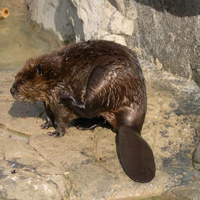
Photo: Clemson University Cooperative Extension
Habitat
The beaver is one of a few mammals, other than man, capable of modifying the habitat to suit its needs. When beavers move into an area, they quickly begin building dams to modify the habitat more to their liking. Once the dam has been built from surrounding trees, the subsequent flooding causes the trees to die and other aquatic plants to begin growing. Often the new plant growth around the edge of a pond (willows, blackgum, and sweetgum) are preferred beaver foods.
Feeding Behavior
Beavers feed on the cambium layer (just under the bark) of woody plants and a variety of aquatic and upland vegetation. Preferred woody foods include willows, birch, maple, alder, cherry, and poplar, although they can and will feed on the leaves, twigs, and bark of more than 40 woody species. During the summer, they also eat water lilies, pond weeds, and cattails. Sometimes beavers travel substantial distances from the pond or stream to get to corn or soybean fields, where they cut the entire plant off at ground level and drag it back to the water. What they do not eat, they use for constructing dams and lodges.
For more information visit: https://www.clemson.edu/extension/natural_resources/wildlife/publications/fs3_aquatic_furbearers.html
Big Brown Bat
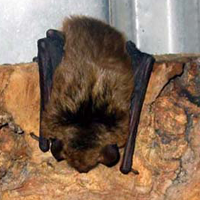
Photo: Southeastern Outdoors
Habitat
Mostly found roosting under loose bark or in the cavity of a tree. However, they will also utilize caves and cracks in rocks. They have also been found in buildings and under eves. In the winter time, they either hibernate living off of stored fat, or they migrate to warmer climates where food is still available.
Feeding Behavior
Big Brown Bats are insectivore, so they only eat insects. Including beetles, wasps, bees, flies and more. Usually hunting above the tree canopy, they are one of the first bats to emerge in the evening. They find their food using echolocation.
For more information visit: https://www.southeasternoutdoors.com/wildlife/mammals/big-brown-bat.html
Coyote
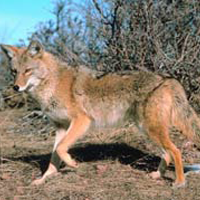
Photo: SC Department of Natural Resources
Habitat
Though traditionally believed to be adapted to live in open areas, coyotes have expanded into most types of habitats. While they do well in agricultural communities, their relatively high tolerance for human populations allows coyotes to exist in most areas of South Carolina. This includes mountainous regions, swamps, dense forests, as well as suburban areas.
Feeding Behavior
Coyotes are opportunistic feeders, preying upon rabbits, rodents, and other small mammals, supplementing their diet with fruits, berries, and insects. They will eat carrion and will also prey upon deer fawns and occasionally on adult deer. One study on the Savannah River Site in Aiken County revealed that coyotes were preying upon more than half the deer fawns born.
For more information visit: https://www.dnr.sc.gov/wildlife/species/coyote.html
Eastern Cottontail
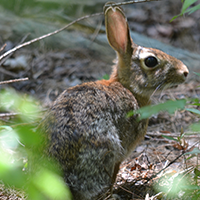
Photo: Zach Steinhauser
Habitat
These rabbits seek out habitat on the fringes of open spaces, such as fields, meadows, and farms, but can adapt to other habitats—including those of humans.
Feeding Behavior
They browse at night on grasses and herbs and are fond of garden fare such as peas and, of course, lettuce. In winter, their diet becomes a bit coarse and consists of bark, twigs, and buds. During the day, cottontails often remain hidden in vegetation.
For more information visit: https://animals.nationalgeographic.com/animals/mammals/cottontail-rabbit/
Eastern Mole
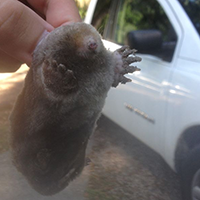
Photo: Zach Steinhauser
Habitat
Cities, suburbs & towns, meadows & fields, scrub, shrub & brushlands, grasslands & prairies, forests and woodlands.
Feeding Behavior
Active year-round, and feeds on a variety of invertebrates including earthworms and ant larvae. About 99% of their time is spent underground, in tunnels and associated chambers.
For more information visit: https://www.enature.com/fieldguides/detail.asp?recnum=MA0052
Flying Squirrel
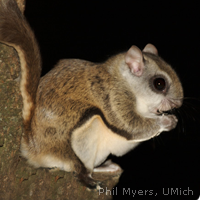
Photo: Phil Myers/UMich
Habitat
Flying squirrels live in deciduous and coniferous forests and woodlands. They make their homes in snags, woodpecker holes, nest boxes, and abandoned nests of birds and other squirrels. Sometimes multiple squirrels will nest together to keep warm in the winter.
Feeding Behavior
Flying squirrels are omnivores. They eat a variety of foods including seeds, nuts, fungi, fruit, and insects. Southern flying squirrels are considered to be one of the most carnivorous squirrels because they supplement their diet with eggs, birds, and carrion.
For more information visit: https://www.nwf.org/Wildlife/Wildlife-Library/Mammals/Flying-Squirrels.aspx
Gray Fox
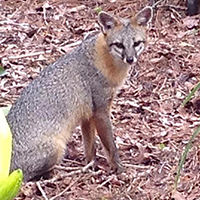
Photo: Zach Steinhauser
Habitat
The gray fox is considered a woodland inhabitant. While it benefits from an interspersion of forests and fields, it can also be found in fully timbered areas. In mixed areas of open land and woods, gray foxes’ ranges may overlap those of red foxes. Unlike the red fox, the gray can climb trees and does so occasionally to escape predators and hunting dogs. The gray fox’s ability to climb and its adaptation to completely forested areas may explain why they have not been displaced by coyotes, as red foxes have in some areas.
Feeding Behavior
The primary food of the gray fox is small mammals such as rats, mice, and rabbits. They have been known to occasionally feed on poultry, small birds, and insects. Plant foods are more important to the gray fox than the red fox. Grays commonly eat persimmons, grapes, and acorns. They will also eat carrion.
For more information visit: https://www.dnr.sc.gov/wildlife/species/grayfox.html
Gray Squirrel
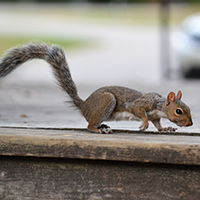
Photo: Zach Steinhauser
Habitat
Hollow den trees are essential to squirrels for winter shelter and rearing of young. Research has shown that survival of litters is usually about 2.5 times as high in den trees as in leaf nests. Adult females with young will not tolerate other squirrels in the same den tree. Considering that only about 50 percent of the hollow trees identified from the ground up as suitable den trees, plenty of hollow trees are needed to satisfy the squirrel population. Known den trees should be marked and protected from cutting. Adult squirrels usually frequent at least two den trees located in their home range. Home range size varies from about 1.5 to 8 acres for individual squirrels, with many ranges overlapping.
Feeding Behavior
Squirrel reproduction and survival fluctuate with the changing availability of heavy-seeded mast (fruit from trees or shrubs), particularly acorns. When the heavy mast is not available, squirrels feed on other fruits and berries, floral parts, buds, bark, roots, mushrooms and some animal matter. About 1-1/2 pounds of mast per week is required for one squirrel from September through March.
For more information visit: https://www.clemson.edu/extension/natural_resources/wildlife/publications/fs13_gray_squirrel_biology_management.html
Little Brown Bat
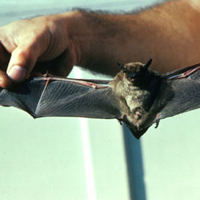
Photo: Don Pfritzer, USFW
Habitat
While most people think of bats living in caves, in the summer time bats live behind bark, in tree’s, jungles, and man-made structures such as buildings, barns, and bridges.
Feeding Habitats
Little Brown Bats are insectivore eating mostly flying insects. Including beetles, wasps, bees, flies and more. Usually hunting above the tree canopy, they are one of the first bats to emerge in the evening. They find their food using echolocation.
For more information visit: https://www.southeasternoutdoors.com/wildlife/mammals/little-brown-bat.html
Muskrat
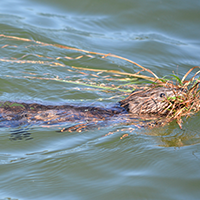
Photo: Zach Steinhauser
Habitat
Muskrats live in a large variety of habitats. The habitat for muskrats is almost anywhere they can find a year-round supply of food and water. They are found in ditches, streams, marshes, lakes, beaver ponds, mine pits, farm ponds, or any wetland area. For shelter they use bank burrows, houses built of vegetation and feeding huts. Bank burrows are usually 6 inches by 8 inches and are up to 60 inches long. Muskrats use bank dens mostly during the summer.
Feeding Behaviour
Muskrats are vegetarians and relish cattails, bulrush, smartweed, duck potato, horsetail, water lily, sedges, young willow sprouts, and pickerel weed. Muskrats will eat almost any aquatic vegetation, including the bulbs, roots, tubers, stems, and leaves of numerous wetland plants. They occasionally eat corn, soybeans, grain sorghum, and small grains. At times, particularly during periods of low food supply, muskrats will eat animals, including crayfish, mussels, turtles, frogs, or fish.
For more information visit: https://www.clemson.edu/extension/natural_resources/wildlife/publications/fs3_aquatic_furbearers.html
Nine-banded Armadillo
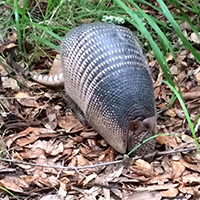
Photo: Zach Steinhauser
Habitat
The nine-banded armadillo inhabits the dense shady woodlands or pine forests. They are found in a warm and rainy environment, mostly in the in those regions that resemble their ancestral home. They are found in Peru, North Argentina and some regions of USA. They stay in deep burrows during the day but are more active at the night. They cannot stay in cold and dry environments since they are only susceptible to dry and hot weather. It is also found in forests and rainforests. It is an easily adaptable animal, and therefore can easily thrive in any region in open prairies, scrublands, and rainforests. It prefers sandy or loamy soil to stay so that it can easily be excavated. They have many burrows, but they up one to bring up their young one.
Feeding Behavior
The nine-banded armadillos are insectivores. They collect their food by digging the soil with their snouts in the soil that they select is loose. They also have a long tongue, with the help of which they grab ants, grubs, termites, and worms. They had peg-like teeth. Their tongue is sticky; therefore they can wrap up the insects in their tongue. This diet is accompanied by small reptiles, amphibians, and tubers.
For more information visit: https://www.animalspot.net/nine-banded-armadillo.html
Raccoon
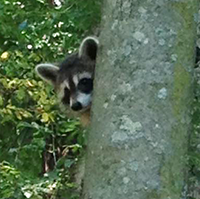
Photo: Zach Steinhauser
Habitat
Raccoons occupy a variety of habitats but are mostly associated with aquatic areas. Raccoons are common in the coastal marshes and in bottomland hardwoods. Swamps with mature hardwood timber are preferred because of the availability of food and den trees. Other important areas are wooded streams flowing through agricultural areas and beaver ponds. The conversion of hardwoods to monoculture pines, the destruction of streamside timber, and development of coastal islands have reduced raccoon numbers in some areas.
Feeding Behavior
Raccoons commonly feed on crayfish, clams, frogs, salamanders, snails, and turtles. They are infamous predators of bird nests, particularly waterfowl. The diet also includes a wide variety of plant foods including acorns, berries, and wild grapes. During the winter months acorns may compose as much as 50% of the diet. During certain seasons of the year raccoons invade agricultural fields to feed on corn, watermelons, and peanuts and can cause some damage. Raccoons will scavenge on carrion and often invade household garbage.
For more information visit: https://www.dnr.sc.gov/wildlife/species/raccoon.html
Red Fox
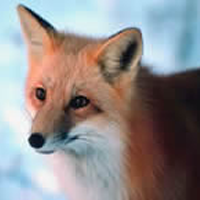
Photo: SC Department of Natural Resources
Habitat
The red fox favors open areas mixed with small woodlots and hedgerows. In the Pee Dee region of the state, it has found an ideal home around tobacco fields and commonly digs dens under old abandoned tobacco barns. Since red foxes do not climb trees like gray foxes do, they use underground dens for escape and resting. Red foxes are also numerous on the pasture lands of the Piedmont region.
Feeding Behavior
Red foxes feed on rabbits, mice, birds, and insects and also eat fruits and berries. Carrion will be eaten when found. They are opportunistic feeders, taking any acceptable food in proportion to availability.
For more information visit: https://www.dnr.sc.gov/wildlife/species/redfox.html
River Otter
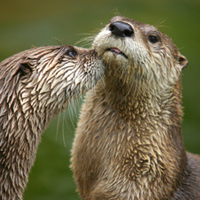
Photo: Clemson University Cooperative Extension
Habitat
Otters prefer a wide variety of aquatic and wetland habitats. In general, otter habitat consists of any area that has a stable water level, an ample food supply (primarily fish), and no water pollution. Home to an otter is a beaver lodge, overhanging bank and previously excavated burrow, or root wads. Many river otter den sites are of beaver origin, either bank dens or lodges. Otters frequent these sites even when beavers are present in the lodges. Otters have also been observed using man-made Canada goose nesting platforms as daytime resting sites.
Feeding Behaviour
The feeding habits of river otters have been extensively studied. Otters are primarily fish eaters, although crayfish are also a favored food. Snakes, frogs, salamanders, snails, insects, clams, earthworms and a variety of mammals and birds have been recorded in otter diets. Otters’ feeding preference is usually based on what is available at the specific location. In the southern portion of their range where fish productivity is high, otters eat fish but eat crayfish when they are available. The relative abundance of various fish species and their maneuverability determine which fish species are eaten. This means that otters prey more on slow moving fish than on faster-moving species.
For more information visit: https://www.clemson.edu/extension/natural_resources/wildlife/publications/fs3_aquatic_furbearers.html
Striped Skunk
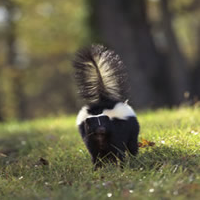
Photo: SC Department of Natural Resources
Habitat
Skunks use a variety of habitat types, preferring woodlands, semi-open farmland, and old abandoned fields. They are often found around farm yards, and their habit of denning under farm buildings and homes causes some problems. In forested areas skunks den in rock piles and under the roots of blown-down trees, or they use their well-developed claws to dig a den in the side of a bank.
Feeding Behavior
Skunks are omnivorous in their feeding habits. Insects are very important, particularly for striped skunks. Other animal matter eaten includes mice, rats, frogs, salamanders, small birds, and eggs. Fruits, berries, and grains supplement the diet in the summer months.
For more information visit: https://www.dnr.sc.gov/wildlife/species/stripedskunk.html
Virginia Opossum
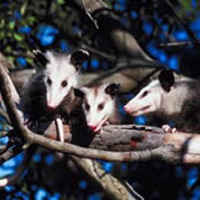
Photo: SC Department of Natural Resources
Habitat
The opossum is one of the most adaptable animals in North America. The diversity of food items it will utilize allows it to live in almost all habitats in South Carolina. Opossums thrive in both woodlands and farmlands and are also commonly found in residential areas.
Feeding Behavior
The opossum diet is the most varied of all furbearers, with insects being the most important item. Opossums are known to eat fruits, crayfish, snails, worms, frogs, salamanders, dead fish and other carrion, mice, snakes, birds’ eggs and sometimes even birds and rabbits.
For more information visit: https://www.dnr.sc.gov/wildlife/species/opossum.html
White-tailed Deer
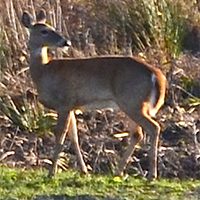
Photo: Zach Steinhauser
Habitat
Quality deer habitat includes a mixture of trees, shrubs, vines, forbs, grasses and other plants such as fungi and sedges. Certain plants within each of these categories benefit deer more than others. Desirable plants should be well interspersed throughout an area so that the whole area functions as deer habitat. Some water source should be available every mile or so. Enough area with appropriate plants should be available to support a viable population.
Feeding Behavior
White-tailed deer are extremely adaptable in their food habits. Deer consume primarily wild herbs, fruits, and agricultural crops; however, they can survive on the leaves, buds, and twigs of woody trees and shrubs when other foods are scare. When abundant, acorns are the mainstay of the fall and winter diet.
For more information visit: https://www.dnr.sc.gov/wildlife/species/deer.html
Banded Water Snake
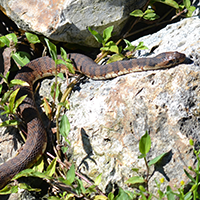
Photo: Zach Steinhauser
Description
Banded watersnakes are mid-sized — 24-48 in (61-106.7 cm) -– fairly heavy-bodied semi-aquatic snakes. Coloration is variable, with snakes ranging from light brown or reddish to black in ground-color with darker crossbands. Crossbands are larger on the middle of the back and narrower on the sides (unlike the bands of copperheads, Agkistrodon contortrix, which are hourglass-shaped). Crossbands may be obscured as the snake darkens with age, and some individuals appear uniformly dark. In addition to crossbands, there are squarish spots at the sides of the belly and a dark stripe from the eye to the angle of the jaw.
Habitat
Banded watersnakes are commonly seen in the vicinity of many aquatic habitats and are active both day and night. They may be seen basking on logs or branches overhanging the water or foraging in shallow water for fish and amphibians, their principal prey. Watersnakes are viviparous, giving birth to 15-20 young in late July or August.
For more information visit: https://srelherp.uga.edu/snakes/nerfas.htm
Black Racer
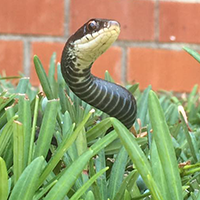
Photo: Zach Steinhauser
Description
As their name implies, black racers are relatively large — to 60 in (152 cm) — fairly slender, solid black snakes. They have smooth scales, large eyes, and often have some white coloration under their chin. The belly is uniformly dark gray or black. Adult racers can be mistaken for any of the other large black snakes present in our region including black rat snakes (which are restricted to the Piedmont and Mountains in our region), black-phase eastern hognose snakes, eastern or black kingsnakes, or dark coachwhips. However, black racers are more slender and uniformly black than those species. Additionally, racers lack the upturned nose of hognose snakes and keeled scales of hognose and rat snakes. When observed from a distance, behavior is often the best way to differentiate a racer from other species. While rat snakes, king snakes, and hognose snakes freeze when approached, racers usually flee rapidly or sometimes stand their ground and attempt to strike.
Habitat
Black racers are only active during the daytime and are most active in warm weather. At night and during cool weather they take refuge in burrows or under covers such as boards or tin. Racers hunt by sight and are often observed actively foraging during the day. They are not active at night. They eat a wide variety of prey including insects, lizards, snakes, birds, rodents, and amphibians. In turn, they are preyed upon by a variety of predatory birds, mammals, and snakes such as kingsnakes and larger racers. When captured, prey is not constricted and are consumed alive. Racers are faster than most other snakes, very agile, and flee when approached, often climbing into small trees or shrubs. If cornered, however, they do not hesitate to bite. Although primarily terrestrial, they climb well and are occasionally observed sleeping in vegetation at night. Racers mate in the spring, and females lay up to 36 eggs in early summer. Eggs hatch in late summer or early fall.
For more information visit: https://srelherp.uga.edu/snakes/colcon.htm
Black Rat Snake
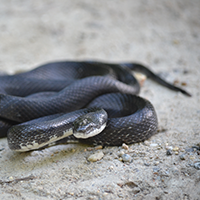
Photo: Zach Steinhauser
Description
Adult rat snakes are typically 3-5 ft (91-152 cm), but large individuals may be more than 6 ft (183 cm) long. The appearance of rat snakes varies greatly throughout the geographic range. Black rat snakes are more northern in distribution and are characteristically black on top with a faint hint of white between some of the scales. Yellow rat snakes are greenish, yellow, or orange with four dark stripes running the length of the body. Gray rat snakes are dark to light gray with darker gray or brown blotches. The juveniles of all subspecies resemble the gray rat. The belly is whitish in color near the head and becomes checkered or mottled toward the tail. The body cross section is loaf-shaped and not round. Rat snakes have weakly keeled scales and the anal plate is divided.
Habitat
Adult rat snakes primarily eat mice, rats, squirrels, and birds, as well as bird eggs. They are a common predator on wood duck eggs. Juveniles eat small frogs, lizards, and small rodents. Rat snakes are constrictors, and adept climbers that can scale brick walls as well as tree trunks. When frightened they often assume a “kinked” posture and remain motionless. They will vibrate the tail and expel malodorous musk.
For more information visit: https://srelherp.uga.edu/snakes/elaobs.htm
Brown Snake

Photo: Zach Steinhauser
Description
Brown snakes are small -– 6-13 in. (17-33 cm) -– snakes that are usually brown, but can be yellowish, reddish, or grayish-brown. They usually have two rows of dark spots, sometimes linked, along the back and a dark streak down the side of the head. The belly is light brown to white. A series of tiny black dots are often present along each side of the belly. The young have a yellowish collar going down the neck with a less evident dorsal pattern. This snake looks similar to earth snakes (Virginia sp.), but those species lack spots on the back and head.
Habitat
Brown snakes hide under covers such as leaf litter and logs, but are sometimes active in the evening or at night, occasionally being seen crossing roads. They feed nearly exclusively on soft-bodied invertebrates such as slugs and earthworms. Brown snakes are viviparous, with females giving birth to 3-31 young in late summer. They probably reach sexual maturity at 2 – 3 years of age.
For more information visit: https://srelherp.uga.edu/snakes/stodek.htm
Coachwhip
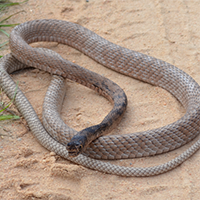
Photo: Zach Steinhauser
Description
Although fairly slender, coachwhips are among the longest snakes in our region, reaching over 8 feet (244 cm). Their coloration is very distinctive, fading gradually from black on the head to tan or nearly white on the tail. The proportion of black to tan varies across our region and individuals in southern Georgia, and Florida can be nearly completely tan. The pattern of scales on the tail resembles a braided whip, giving the snake its common name. Young coachwhips are very slender and completely tan with irregular darker bands and white markings on the head and neck. Coachwhips have large eyes and excellent vision.
Habitat
Coachwhips are only active during the daytime and are most commonly seen in hot weather. In fact, coachwhips are frequently observed during the hottest summer weather when other snakes are inactive. At night and during cool weather coachwhips take refuge in burrows or under covers such as boards or tin. Coachwhips hunt by sight and actively pursue prey, often with their head held high above the ground. They eat a wide variety of prey including insects, amphibians, lizards, snakes, birds, and rodents. In many areas lizards are particularly important prey and coachwhips are even able to chase down race runners and skinks.
For more information visit: https://srelherp.uga.edu/snakes/masfla.htm
Copperhead
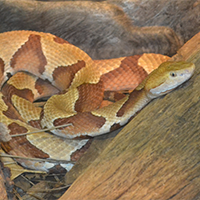
Photo: Zach Steinhauser
Description – Venomous
Copperheads are fairly large – 24 – 40 in (61 – 102 cm), heavy-bodied snakes with large, triangular heads and elliptical pupils (cat eyes). The body is tan to brown with darker hourglass-shaped crossbands down the length of the body. Individuals from the Coastal Plain often have crossbands that are broken along the center of the back. The head is solid brown, and there are two tiny dots in the center of the top of the head. Juveniles resemble adults but have a bright yellow tail tip. As pit-vipers they have facial pits that sense heat and are used to detect prey and predators. Male copperheads are larger than females. Many harmless species in our region are confused with this species but copperheads are the only species with hourglass-shaped crossbands (all other species have blotches that are circular, square, or are widest down the center of the back).
Habitat
Copperheads can be found during the day or night, but forage primarily after dark during the hotter parts of the season. In the Piedmont and Coastal Plain they are frequently observed crossing roads on warm nights. In the mountains, copperheads are often found by day basking on rock outcrops or coiled in ambush postures. Copperheads are opportunistic feeders and are known to consume a variety of prey, including amphibians, lizards, snakes, small mammals, birds, and insects. Copperheads mate in the spring, at which time males move long distances in search of females. Luckily, copperhead venom is not very potent and deaths from copperhead bites are exceedingly rare. Most snake bites occur when someone tries to kill or harass a snake, so the best way to avoid a bite is to leave any snake you find alone.
For more information visit: https://srelherp.uga.edu/snakes/agkcon.htm
Coral Snake
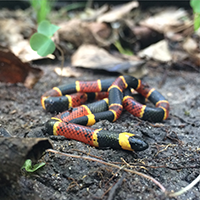
Photo: Zach Steinhauser
Description – Venomous
Adult eastern coral snakes are slender, medium-sized — 18-30 in (46-76 cm) — snakes that may reach almost 4 feet (122 cm) in length. They have smooth scales, and the anal plate is usually divided. The most obvious feature of an eastern coral snake is the bright body pattern of red, yellow, and black rings in which the red and yellow rings touch each other. The nose is black. Scarlet kingsnakes (Lampropeltis triangulum elapsoides) and scarlet snakes (Cemophora coccinea) are superficially similar, but the red only touches the black rings. The coral snake is the only eastern species of snake with a pair of fixed fangs in front of the mouth.
Habitat
Coral snakes are rarely seen in most areas where they occur, probably because they are highly secretive and spend most of their time underground. They typically do not climb trees or shrubs and spend only limited time crawling above ground. Most sightings of coral snakes are in the spring and fall. When threatened, coral snakes often elevate and curl the tip of their tail. They are noted for preying primarily on other snakes and lizards, which they kill by injecting with venom. Eastern coral snakes lay an average of six or seven eggs in early summer and the young hatch in late summer or early fall. Perhaps because of their secretive habits, coral snakes often persist suburban areas.
For more information visit: https://srelherp.uga.edu/snakes/micful.htm
Corn Snake
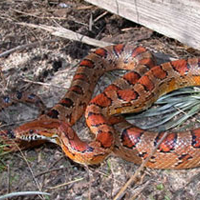
Photo: J.D. Willson
Description
A fairly large — 76-122 cm (30 – 48 in) — relatively slender snake that is orange, reddish brown, brown, or gray with 27-40 squarish black-margined brown or reddish blotches. The belly is checkered with white and black markings, resembling a piano keyboard or Indian corn. Other distinguishing characteristics include a spear-shaped blotch on top of the head, pointing toward the nose, black stripes on either side of the bottom of the tail, smooth scales, and a stripe extending from the back of the eye past the corner of the jaw. Corn snakes are often mistaken for venomous copperheads. Copperheads, however, have hourglass-shaped (rather than square) blotches, and are generally browner than corn snakes.
Habitat
Corn snakes spend most of their time underground or hidden under objects such as logs, boards, or pieces of roofing tin. They climb well and young ones are often found hiding under tree bark or climbing in brush. Corn snakes are active both day and night, but become primarily nocturnal in the warm summer months. They eat a variety of mammals, birds, and reptiles, and young snakes are particularly fond of lizards. Corn snakes lay large clutches of oval eggs in the spring in rotten logs or other warm, moist places.
For more information visit: https://srelherp.uga.edu/snakes/elagut.htm
Diamondback Rattlesnake
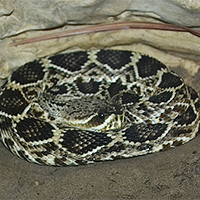
Photo: Zach Steinhauser
Description – Venomous
The eastern diamondback rattlesnake is the largest of the 32 species of rattlesnake currently recognized. They are large, heavy-bodied snakes with large, broad heads with two light lines on the face. Adults are usually 33-72 in (84-183 cm) long, but the largest individual on record was 96 in (244 cm). Mature snakes can tip the scales at over 10 lbs. The background color is brown, tan, or yellowish and covered with the namesake diamonds, which are brown and surrounded by lighter scales. Males are larger than females.
Habitat
Like most large pitvipers eastern diamondbacks spend most of their time coiled in palmetto thickets or other thick vegetation to ambush prey. Most movement between locations occurs during the day and is mostly restricted to the morning and evening in summer. Diamondbacks spend the winter in stump holes or tortoise burrows but may emerge on warm winter days to bask. This species feeds almost exclusively on mammals, particularly rabbits. Mating occurs in the spring and fall, and females give birth to 12 – 24 young in the late summer. Diamondbacks grow slowly, taking several years to reach maturity, and adult females only reproduce every 2-3 years.
For more information visit: https://srelherp.uga.edu/snakes/croada.htm
Eastern Kingsnake
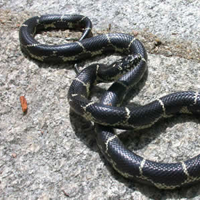
Photo: J.D. Willson
Description
Eastern kingsnakes are large — 36 – 48 in (90-122 cm) — shiny-black, smooth-scaled snakes with white or yellow chain-link bands that cross the back and connect along the sides. Because of this pattern, this species is also referred to as the chain kingsnake. Generally, individuals from the Coastal Plain have wide bands while those from the mountains may have very thin bands or be nearly completely black. Eastern kingsnakes have a short stout head and small beady eyes. They have an undivided anal plate.
Habitat
In our region kingsnakes are active almost exclusively by day but are most active in the morning during the summer. They are strong constrictors and consume a variety of prey including snakes, lizards, rodents, birds, and especially turtle eggs. Kingsnakes are resistant to the venom of pit-vipers, and they readily eat copperheads, cottonmouths, and rattlesnakes. Although they frequently rattle their tail, release musk, and bite upon capture, they tame quickly and are often kept as pets. This species mates in the spring and males bite the neck of females while mating. Females lay 3-24 eggs under debris or in rotting logs in early summer and eggs hatch in August-September.
For more information visit: https://srelherp.uga.edu/snakes/lamget.htm
Garter Snake
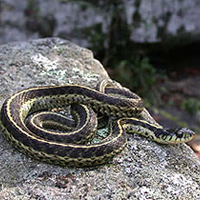
Photo: J.D. Willson
Description
Thamnophis sirtalis is usually 18 – 26 in (45.7 – 66 cm) long, but occasionally reaches lengths up to 49 in (124 cm). Most individuals can be distinguished from other species by the presence of three yellow longitudinal stripes down a dark body. Some, however, exhibit a checkered body pattern with light stripes and a grayish or reddish body color. Additionally, in garter snakes, the lateral yellow lines are on scales 2 and 3 whereas they are on scale rows 3 and 4 in ribbon snakes. On garter snakes, they are on scales 2 and 3. Males have longer and thicker tails than females.
Habitat
Garter snakes may be active by day or night and are often found under boards or other debris. They are viviparous (give birth to live young) and sometimes have more than 50 babies. Common garter snakes feed on worms, slugs, frogs, toads, salamanders, fish and tadpoles. They may be active throughout the year, including warm winter days.
For more information visit: https://srelherp.uga.edu/snakes/thasir.htm
Pygmy Rattlesnake
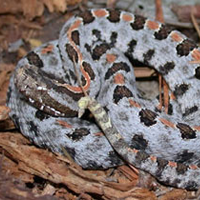
Photo: J.D. Willson
Description – Venomous
This small — 14–22 in (38-56 cm) — rattlesnake belongs to the genus Sistrurus and is commonly referred to as a pigmy rattler or ground rattler. Unlike the larger rattlesnakes of the genus Crotalus, this species has nine large scales on top of the head and a tiny rattle that can seldom be heard. There are three subspecies of pigmy rattlesnakes, of which two occur in Georgia (Sistrurus miliarius miliarius – the Carolina pigmy rattler and Sistrurus miliarius barbouri – the dusky pigmy rattler). Both subspecies have a row of mid-dorsal spots and a bar than runs from the eye to the base of the mouth, but the color of this bar can vary from black to brownish red. An orange or reddish brown dorsal stripe is also present on both subspecies. In young snakes, the tip of the tail is sulfur yellow and is used for caudal luring. The Carolina pigmy rattler can be gray, tan, or lavender.
Habitat
Pigmy rattlesnakes spend most of their time well-hidden among leaf litter and can be very hard to spot. From such hiding places, they ambush a variety of prey including lizards, frogs, small mammals, and insects as well as centipedes. These snakes are most often encountered crossing roads on summer evenings. Females give birth to live young in the late summer or fall.
For more information visit: https://srelherp.uga.edu/snakes/sismil.htm
Red-bellied Water Snake
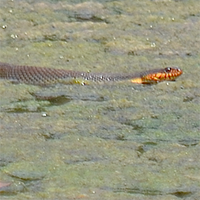
Photo: Zach Steinhauser
Description
The redbellied snake is a small woodland snake, ranging from 4 – 10 in (10 – 25 cm) long. This species is one of our most variably-colored snakes, with some individuals ranging from bright orange to brown, gray, or nearly black. Occasionally individuals are found that are gray with a brown or orange stripe down the center of the back. Many individuals have a light brown ring behind the head. This species can easily be distinguished from all other small woodland snakes by their unmarked, bright orange to the red underside.
Habitat
Redbellied snakes are generally very secretive and can be found hiding under logs, rocks, and leaf piles. They feed nearly exclusively on slugs. Redbellied snakes breed in the spring or fall, and females give birth to 4 – 9 (but up to 23) young, in summer. They probably reach sexual maturity within 3 years. Research at the Savannah River Ecology Lab has shown that this species tracks the changing boundaries of wetlands as they fill and dry, probably following areas where the most slugs are found. When threatened this species rarely bites but adopts a bizarre lip-curling behavior.
For more information visit: https://srelherp.uga.edu/snakes/stoocc.htm
Ribbon Snake
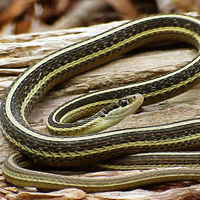
Photo: J.D. Willson
Description
Ribbon snakes are slender snakes that range from 16-28 in. (41-71 cm) long. They have three light, usually yellow, stripes (two along the sides and one down the center of the back) against a dark background. Between the yellow lateral stripes and the belly, there is a brown lateral stripe. Ribbon snakes resemble the closely-related eastern garter snake (Thamnophis sirtalis), however, ribbon snakes are more slender, have unpatterned lip scales, and the lateral stripes are found on scale rows 3 and 4 (in garter snakes they are on rows 2 and 3).
Habitat
Ribbon snakes eat small fish and amphibians and often swim in the water near the shoreline. After reproduction, the male inserts a copulatory plug to prevent other males from mating with that particular female. Ribbon snakes are viviparous, with females giving birth to live young in the late summer.
For more information visit: https://srelherp.uga.edu/snakes/thasau.htm
Ringneck Snake
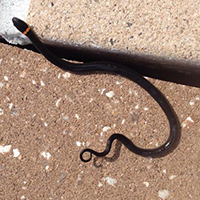
Photo: Zach Steinhauser
Description
Ringneck snakes are small — 10 – 15 in (25 – 38 cm) — slender snakes that are generally grayish with a yellow or orange band around the back of the neck and a yellow or orange underside. Two subspecies are found in our region. The northern ringneck snake (Diadophis punctatus edwardsi) inhabits the mountains and generally has a complete neck ring and unpatterned underside. The southern ringneck (D. p. punctatus) is found in the Coastal Plain and often has a broken neck ring and underside that is marked with a single row or black spots. The northern ringneck is also generally larger than the southern. Although usually grayish in coloration, both subspecies may range from nearly black to tan and both have smooth scales and round pupils. Females are larger and have proportionally shorter tails than males.
Habitat
Like other small woodland snakes in the Southeast, ringneck snakes spend most of their time underground or hidden under logs, rocks, leaf litter, or debris. However, ringnecks can occasionally be found crawling in the open or crossing roads, often at night. Ringnecks are one of the more common species in many habitats in the Southeast and in other parts of their range can reach extraordinary densities.
For more information visit: https://srelherp.uga.edu/snakes/diapun.htm
Rough Green Snake
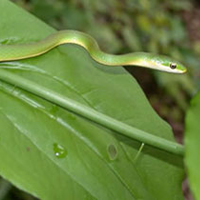
Photo: J.D. Willson
Description
Rough Green Snakes are fairly long – to 32 in (81 cm) – slender, bright green snakes with yellow or whitish bellies that spend much of their time climbing in vegetation. Their bright green color easily distinguishes them from all other snakes in Georgia and South Carolina, but the similar Smooth Green Snake replaces this species in the Appalachian Mountains and the Northeast. Rough Green Snakes have keeled scales and large eyes. After death the color of green snakes fades to blue or black and dead individuals may resemble small black racers. Young Green Snakes resemble adults.
Habitat
Rough Green Snakes are probably the most arboreal snakes in our region and spend the majority of their time hunting for insects, spiders, and other invertebrates in vegetation well above the ground. When encountered, green snakes often freeze, relying on their green coloration for camouflage. At night, Green Snakes can often be found sleeping coiled in shrubs, vine tangles, or thick vegetation. During cool weather Green Snakes often take refuge on the ground and can sometimes be found hiding beneath logs, rocks, or debris. They mate in the spring and females lay 3 – 12 eggs in the early summer.
For more information visit: https://srelherp.uga.edu/snakes/ophaes.htm
Scarlet Snake

Photo: J.D. Willson
Description
Scarlet snakes are fairly small — to 20 in (51 cm) — relatively slender snakes that are patterned with alternating red, black, and white or yellow bands. Scarlet snakes are one of the three “tricolored” snakes in our region and, like the harmless scarlet kingsnake, have red bands that do not touch yellow bands. However, this species can be distinguished from the scarlet kingsnake because the kingsnake’s bands completely or nearly completely encircle the body while the bands of the scarlet snake do not extend onto the venter, leaving the underside solid white, pink, or grayish. The venomous eastern coral snake has a black snout and red bands that touch yellow ones. Scarlet snakes have a snout that is pointed and red and red bands that are wider than bands of other colors. Young resemble adults.
Habitat
Like many of the small fossorial snakes in our region, scarlet snakes spend most of their lives underground and are most frequently encountered hiding beneath logs, rocks, leaf-litter, or debris such as boards, tin, or trash. Scarlet snakes are never active above ground during the day: however, at night scarlet snakes do move above ground and are often encountered crossing rural roads on hot summer nights. Scarlet snakes feed primarily on eggs of other reptiles and have enlarged teeth that they use to open eggs that are too large to swallow whole. They also occasionally consume small lizards, snakes, and frogs. Little is known about the reproductive biology of this species, but females are known to lay 2 – 9 eggs in the early summer.
For more information visit: https://srelherp.uga.edu/snakes/cemcoc.htm
Timber Rattlesnake
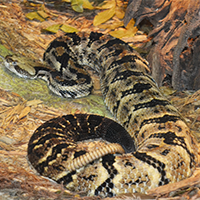
Photo: Zach Steinhauser
Description – Venomous
Timber rattlesnakes, which are called canebrake rattlesnake in the Coastal Plain of the Southeast, are large, heavy-bodied snakes with the characteristic rattles on the end of the tail. Adults range from 30-60 in (76-152 cm) with the record being more than 6 feet (183 cm) long. Canebrakes are usually gray and may even have a pink hue and a pinkish, yellow, orange, or brown stripe running the length of the back. Timber Rattlers are typically more brown or yellowish and may even be black. Both forms have solid black tails that appear almost velvet and black chevrons on the back and sides with the point of the (V) pointing forward. The babies are miniatures of the adults but are usually a lighter gray and have only a single button (rattle) on the tip of the tail at birth. Males get larger than females.
Habitat
Timber and canebrake rattlesnakes become active above ground by late spring and can be seen periodically until the onset of cold weather in late fall. Canebrakes are active during both day and night but spend the majority of their time coiled in ambush positions ready to capture prey.
For more information visit: https://srelherp.uga.edu/snakes/crohor.htm
Water Moccasin
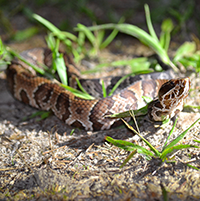
Photo: Zach Steinhauser
Description – Venomous
Cottonmouths are venomous semi-aquatic snakes often referred to as “water moccasins.” They have large, triangular heads with a dark line through the eye, elliptical pupils, and large jowls due to the venom glands. They are large – typically 24 – 48 in (61 – 122 cm), occasionally larger, keeled-scaled, heavy-bodied snakes. Their coloration is highly variable: they can be beautifully marked with dark crossbands on a brown and yellow ground color or completely brown or black. Older adults are often dark and solid-colored whereas the juveniles are brightly patterned with a sulphur yellow tail tip that they wiggle to attract prey. The belly typically has dark and brownish-yellow blotches with the underside of the tail being black. As pit-vipers, they have facial pits that sense heat and are used to detect prey and predators. Male cottonmouths are larger than females.
Habitat
Cottonmouths can be found during the day or night, but forage primarily after dark during the hotter parts of the season. Throughout much of their range, they can be found year-round, even in sunny days in the winter. Cottonmouths bask on logs, rocks, or branches at the water’s edge but seldom climb high in trees (unlike many of the nonvenomous watersnakes which commonly bask on branches several feet above the water). They employ both ambush and active foraging strategies. Cottonmouths are opportunistic feeders and are known to consume a variety of aquatic and terrestrial prey, including amphibians, lizards, snakes (including smaller cottonmouths), small turtles, baby alligators, mammals, birds, and especially fish. Cottonmouths mate in the early summer at which time male-to-male combat occurs in competition for females.
For more information visit: https://srelherp.uga.edu/snakes/agkpis.htm
Alligator

Photo: Zach Steinhauser
Description
Alligators are long-lived animals whose life spans can exceed 60 years. Alligators are “cold-blooded,” meaning that they are ectothermic animals that cannot regulate their body temperature, but assume the temperatures of their surrounding environment. To warm themselves, alligators bask in the sun, which is when they are frequently observed on the banks of water bodies. On hot summer days, they can sometimes be seen basking with their mouths open. This is a cooling mechanism essentially equivalent to a dog panting. Ecologically, alligators are important predators and create important habitat for other wildlife by digging holes that hold water during droughts.
Habitat
Alligators live in swampy areas, rivers, streams, lakes, and ponds. Females and juveniles occasionally use seasonal wetlands. Although they are primarily freshwater animals, alligators will also venture into the brackish salt water.
For more information visit: https://srelherp.uga.edu/alligators/allmis.htm
Broadhead Skink
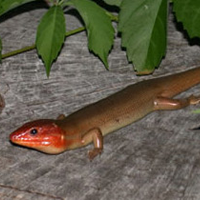
Photo: J.D. Willson
Description
Broadhead skinks are the largest skink in the southeast, and with the exception of the glass lizards, are the largest lizards in our region. These large lizards have short legs and a streamlined body. The body is gray, brown, or black, in background color with five white or yellowish stripes (two on each side and one down the center of the back). However, adults often fade to uniform gray or brown, and mature males develop enlarged orange heads with powerful jaws. Like other skinks, the young have bright blue tails and prominent stripes.
Habitat
Although they may be found both on the ground and in trees, broadhead skinks, particularly large males, are more arboreal (tree-dwelling) than any of the other southeastern skinks. Adults are often seen high up in trees, sunning on exposed branches, while young are common on fallen trees and under bark or other debris. When pursued, broadhead skinks run for the nearest tree or log and can be quite difficult to capture. Like many other lizards, broadhead skinks will break off their tails when restrained, distracting the predator and allowing the lizard to escape.
For more information visit: https://srelherp.uga.edu/lizards/eumlat.htm
Eastern Fence Lizard
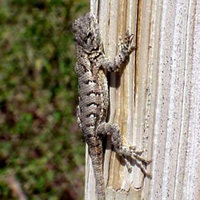
Photo: J.D. Willson
Description
As a member of the spiny lizard family, the Fence lizard is the only lizard native to Georgia and South Carolina that has rough scales. Fence lizards are most commonly grayish in color, but may range from nearly black to brown. Females often have black horizontal patterning on their back, while during the breeding season, males have bright blue patches on their chin and underside.
Habitat
Although sometimes found on the ground, fence lizards are one of our most arboreal (tree-dwelling) lizards and usually dash for the nearest tree when approached. When pursued, the fence lizard will stay on the opposite side of the tree from the predator, in the same fashion as a squirrel.
For more information visit: https://srelherp.uga.edu/lizards/sceund.htm
Eastern Glass Lizard
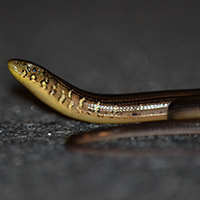
Photo: Zach Steinhauser
Description
Glass lizards are long, slender, legless lizards that superficially resemble snakes. They differ from snakes, though, in that they have moveable eyelids, external ear openings, and inflexible jaws. The eastern glass lizard is the longest and heaviest glass lizard in our region and is light brown or yellowish to greenish in coloration. This species is best distinguished from other glass lizards by the absence of a dark dorsal stripe or dark markings below the lateral groove and the presence of several vertical whitish bars just behind the head. Older individuals are less boldly patterned than younger individuals, often developing a greenish or speckled coloration.
Habitat
Glass lizards forage actively by day in open habitats but are commonly found taking refuge beneath boards and other debris. When seized, glass lizards commonly break off all or part of their tail (which makes up more than half of their total length) and will later regrow. With the predator distracted by the wriggling tail, the lizard is free to escape.
For more information visit: https://srelherp.uga.edu/lizards/ophven.htm
Five-lined Skink
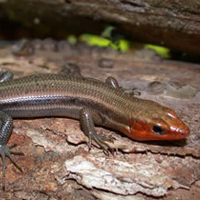
Photo: J.D. Willson
Description
Five-lined skinks are moderately large lizards with short legs and a streamlined body. The body is gray, brown, or black, in background color with five white or yellowish stripes (two on each side and one down the center of the back). Young have a bright blue tail while adult males often loose their stripes and develop reddish or orange coloration on the head.
Habitat
Five-lined skinks may be found on the ground or in trees, but are less arboreal (tree dwelling) than broadhead skinks. Although sometimes seen in the open, these lizards are most often found beneath logs or under tree bark. When pursued, five-lined skinks run for the nearest tree or log and can be quite difficult to capture. Like many other lizards, five-lined skinks will break off their tails when restrained, distracting the predator and allowing the lizard to escape.
For more information visit: https://srelherp.uga.edu/lizards/eumfas.htm
Green Anole
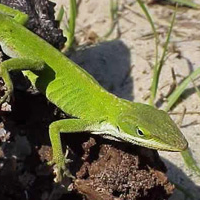
Photo: J.D. Willson
Description
May be either green or brown depending on environmental conditions. When brown, may have faint markings on the back. Males have a pinkish throat fan that is displayed in territorial rivalries or when approaching a potential mate. The green anole is most easily distinguished form the similar brown anole (Anolis sagrei) by green or lightly patterned brown coloration, pinkish throat fan, and by range.
Habitat
Anoles are active by day in warm weather and often bask in vegetation, occasionally charging away from a basking spot to grab and inset or chase off a rival anole. During cool weather, anoles are often found hiding under tree bark, shingles, or in rotten logs. Sometimes many anoles can be found taking refuge in one spot.
For more information visit: https://srelherp.uga.edu/lizards/anocar.htm
Ground Skink
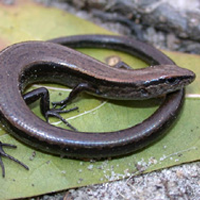
Photo: J.D. Willson
Description
Ground skinks are small, slender lizards with long tails and short legs. They range from golden brown to almost black in coloration but are most often coppery brown with a darker stripe running along each side of the body. The belly is white or yellowish.
Habitat
Unlike many other lizards in our region, ground skinks virtually never climb. Rather than running on their tiny legs, ground skinks use their slender bodies to wriggle or “swim” through leaf litter or loose soil, often disappearing in a flash as soon as they are discovered. Like other lizards, ground skinks will break off their tail to confuse a potential predator.
For more information visit: https://srelherp.uga.edu/lizards/scilat.htm
Six-lined Racerunner
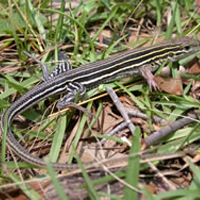
Photo: J.D. Willson
Description
Although the six-lined racerunner is the only lizard in our area with six light yellow or white stripes down its back, the racerunner’s ground-dwelling habits and impressive speed are often sufficient to identify this species from a distance.
Habitat
Racerunners are fond of heat and are active even on the hottest of summer days. They are alert and active, darting between clumps of vegetation to grab insects. During cool weather, night, or when confronted by a predator, racerunners often take refuge in burrows.
For more information visit: https://srelherp.uga.edu/lizards/cnesex.htm
Southeastern Five-lined Skink
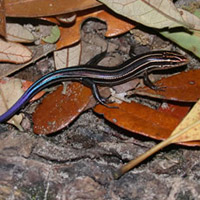
Photo: J.D. Willson
Description
Southeastern five-lined skinks are moderately large lizards with short legs and a streamlined body. The body is gray, brown, or black, in background color with five white or yellowish stripes (two on each side and one down the center of the back). Young have a bright blue tail while adult males’ stripes may fade, and a reddish, or orange coloration may develop on the head. This species is very similar in appearance to the five-lined skink and broadhead skink and is usually only identifiable by close examination of the scales: unlike the other two species, southeastern five-lined skinks do not have an enlarged row of scales under the tail.
Habitat
Southeastern five-lined skinks may be found on the ground or in trees, but are less arboreal (tree dwelling) than broadhead skinks. Although sometimes seen in the open, these lizards are most often found beneath logs or under tree bark. When pursued, these lizards run for the nearest tree or log and can be quite difficult to capture. Like many other lizards, southeastern five-lined skinks will break off their tails when restrained, distracting the predator and allowing the lizard to escape.
For more information visit: https://srelherp.uga.edu/lizards/eumine.htm
Chicken Turtle
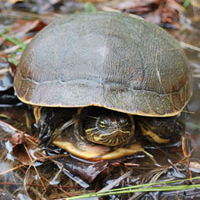
Photo: J.D. Willson
Description
Chicken Turtles are mid-sized turtles (6-9 in; 15-23 cm carapace length) with shells that are egg-shaped (widest over the hind legs) and patterned with a pale yellowish netlike pattern. This species has an extremely long neck that is striped with yellow and also has vertical black and yellow stripes on the “seat of its pants.” The plastron is usually yellow and unmarked, and females reach larger sizes than males.
Habitat
Chicken Turtles occasionally bask but spend most of their time in the water. They hunt amidst aquatic vegetation for prey which includes aquatic insects, amphibian larvae, small fish, and especially crayfish. This species is among the most terrestrial of our turtles and nearly all males and some females leave the wetland each fall to spend the winter buried in the forest. Additionally, during drought, this species aestivates in uplands rather than migrating to other wetlands. Chicken Turtles are unusual among turtles in that they have a winter egg-laying period that begins in late summer and early fall, declines during the coldest months and resumes again in February and March.
For more information visit: https://srelherp.uga.edu/turtles/deiret.htm
Common Musk Turtle
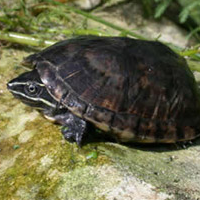
Photo: J.D. Willson
Description
Common musk turtles are small turtles (2 – 5 in; 5-12 cm) with dark brown or black shells that may be streaked or mottled and commonly accumulates green algae. There are two distinct stripes on the head and barbels on both the chin and throat.
Habitat
Musk Turtles are primarily nocturnal, and they are often seen foraging in shallow water in the evening. They are omnivorous (e.g., seeds, insects, snails, tadpoles, algae) and will occasionally scavenge on fish carrion. This species rarely emerges to bask and is most successfully captured with nocturnal trapping techniques. Musk turtles climb surprisingly well and occasionally rest fairly high in trees. Breeding occurs in the spring and fall. Mating often occurs in the water and males bite the female to see if she is receptive before mounting. Females often lay two clutches a season of 1-9 eggs under debris in loamy soils. Clutch size varies with carapace length and age, but environmental factors could be the primary influence. There is geographical variation with time of reproduction and clutch size. Nesting aggregations are occasionally observed. Male-biased sex ratios are observed consistently across populations. This species over-winters in the debris and mud under water. The name “stinkpot” is appropriately assigned due to phenolalkalinic acid excreted from glands that create a pungent musky odor. Females reach sexual maturity at 8-9.5 cm (~ 4 yrs) and males at 6-7 cm (~ 2 yrs).
For more information visit: https://srelherp.uga.edu/turtles/steodo.htm
Common Snapping Turtle
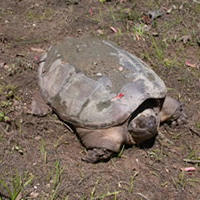
Photo: J.D. Willson
Description
The common snapping turtle is a large turtle, ranging in size from 8 to 14 in (20-36 cm) with a record length of 19.3 in (49 cm). Their average weights range from 10 to 35 lbs (4.5 – 16 kg), with a record of 75 lbs (34 kg). Their color varies from tan to dark brown to almost black in some specimens. Common snapping turtles have long tails and necks and rough shells with three rows of carapace keels.
Habitat
Snapping turtles are highly aquatic and are seldom observed basking. At times, however, they may move long distances over land and many die attempting to cross roads. Although generally docile in water, common snapping turtles will strike viciously if captured or cornered out of water. They mate April – November and typically deposit 20 – 40 eggs in concave nests dug by the female. Common snapping turtles are omnivores, taking a wide variety of vertebrate and invertebrate prey, as well as aquatic vegetation.
For more information visit: https://srelherp.uga.edu/turtles/cheser.htm
Eastern Box Turtle
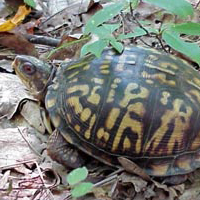
Photo: J.D. Willson
Description
Box Turtles are mid-sized, terrestrial turtles – 4.5-6 in (11.5-15.2 cm) – with a high, rounded shell that is dark with many yellow or orange splotches. The carapace pattern is variable and becomes less prominent with age. There are four toes on each hind foot. Males have a concave plastron and often have red eyes. The plastron (bottom of the shell) is hinged, allowing the box turtle to completely close it shell.
Habitat
With the exception of the Gopher Tortoise (Gopherus polyphemus), this is the most terrestrial turtle in our region. They are most commonly encountered after summer rain storms and in the fall when males actively search out females. Box turtles are omnivorous and eat mushrooms, berries, grapes, persimmons, and other fruits. Although adults are mainly herbivorous, few will turn down a juicy worm, slug, or insect. Box turtles have a low metabolic rate, which allows them to survive during times when food is scarce.
For more information visit: https://srelherp.uga.edu/turtles/tercar.htm
Eastern Mud Turtle
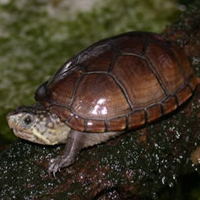
Photo: J.D. Willson
Description
The eastern mud turtle is similar in appearance to the striped mud turtle, except it lacks any prominent striping on its head. The eastern mud turtle appears to have more general habitat requirements than the striped mud turtle, although the two species may occur in the same habitat. Female eastern mud turtles may nest two or three times a year during the spring and summer, often spending several days on land during each nesting event. Although hatchlings will emerge from their eggs in late summer, they remain buried underground until the following spring. Most adults also bury themselves on land in the fall and return to a wetland in the spring. Eastern mud turtles are ubiquitous in the Southeast being found in most still-water habitats.
For more information visit: https://srelherp.uga.edu/turtles/kinsub.htm
Painted Turtle
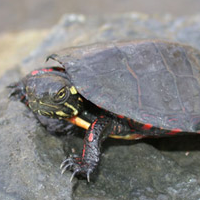
Photo: J.D. Willson
Description
Painted turtles are relatively small turtles (5-7 in; 10-18 cm carapace length), colorful with dark shells and yellow stripes on the legs and, blotches or spots on their heads. The edges of the shell are smooth, not serrated, and may have red or yellow hieroglyphic-like patterns on the edge of the otherwise yellow or orange-yellow plastron. Southern painted turtles are distinguished from other sub-species by a red or yellow stripe that runs down the carapace from head to tail. Their black legs also have red stripes. Females grow larger than males, but adult males have much longer front claws, which they use in mating displays. Hatchlings look like miniature, more brightly-colored adults.
Habitat
Painted turtles have a varied, omnivorous diet and are frequently seen basking on logs or rocks or some other available site. They are most active from March to November, but may be encountered on warm days throughout the year. They mate in early spring (males are known to move between aquatic habitats, presumably looking for mates) with the females coming out of the water to nest during the day in May and June.
For more information visit: https://srelherp.uga.edu/turtles/chrpic.htm
River Cooter

Photo: J.D. Willson
Description
The river cooter is a fairly large turtle (up to 12 inches) often observed basking on rocks and logs along the banks or in rivers. The olive or brown carapace is slightly flared posteriorly and often highlighted with lighter markings. On the river cooter, a light, backward-facing C-shaped mark on the second scute on each side of the carapace can be used to distinguish it from the Florida cooter turtle. The underside of some marginals is marked by doughnut-shaped dark spots with light centers. The plastron and bridge have dark markings, particularly along the seams between scutes. The head and neck have numerous yellow “hairpin” stripes. The postorbital stripe is not as broad as in the slider turtle, with which it might be confused. Males have straight, elongated foreclaws. Female river cooters lay about 20 eggs in May to June. This species is predominantly herbivorous.
For more information visit: https://srelherp.uga.edu/turtles/psecon.htm
Slider Turtle
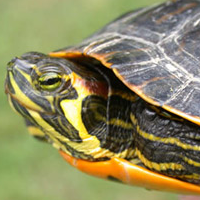
Photo: J.D. Willson
Description
The slider turtle is one of the most ubiquitous and conspicuous species of turtle in the Southeast. It occurs in every type of wetland and is frequently observed basking. Individuals are also commonly encountered on land when moving between aquatic habitats. The carapace is olive to dark brown, slightly keeled, and lightly patterned in some individuals. The plastron and the underside of the marginals are typically marked with two or more large, solid black dots or blotches. Males have elongated foreclaws and long, thickened tails. Some males may also become very dark with age. The yellow stripe behind the eye is broadest directly behind the eye. Nesting females are frequently seen from May through July.
For more information visit: https://srelherp.uga.edu/turtles/trascr.htm
Spiny Softshell
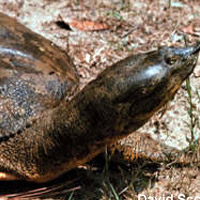
Photo: J.D. Willson
Description
Apalone spinifera are easily distinguished from other turtles because of their different looking carapace. Unlike most turtles in Georgia, the spiny softshell turtle has a flat, leathery shell with very flexible edges, “resembling a pancake.” This carapace can get up to 18″ long in females and only 9″ long in males being an olive, brown to grayish color with dark spots in males and younger turtles. In adult males, the shell has a lot of spines on the carapace, but in females, it only has a few spines.
Habitat
Softshells often bury themselves in the mud or sand where they sleep or wait for food to carelessly swim by. They can sometimes be observed basking on sandbars or logs protruding from the water. These turtles are mainly carnivorous, eating almost anything living in the water that will fit into its mouth. This includes fish, insects, and crayfish. They bury themselves in the sand or mud with only their head sticking out and grab prey as they swim by. Spiny softshell turtles are most active April through October. They usually breed in May and lay 4 to 30 eggs on sunny sandbars or in loose soil.
For more information visit: https://srelherp.uga.edu/turtles/apaspi.htm
Spotted Turtle
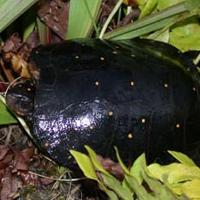
Photo: J.D. Willson
Description
Spotted Turtles are small — 3 ½ – 4 ½ inches (9-11.5 cm) – aquatic turtles that are black in color with yellow spots. Hatchlings usually have one spot per large scute on the shell, but adult spotting patterns are variable. The shell is flattened, and there is orange or yellow coloration on the head, neck, and forelegs. Males have longer tales than females.
Habitat
Relatively little is known about Spotted Turtle Biology in the Southeast, and they appear to have quite different activity patterns from other aquatic turtles. These turtles appear to be most common in the early spring when they can be seen basking on logs in wetlands. Data from radio-telemetry suggests that Spotted Turtles spend much of the warmer months buried on land. Sexual maturity is reached at 8-10 years, and the turtles may live as long as 25 years. Diet consists of snails, worms, slugs, and insects.
For more information visit: https://srelherp.uga.edu/turtles/clegut.htm
American Toad
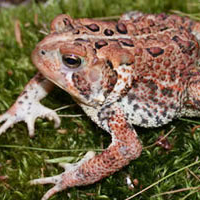
Photo: J.D. Willson
Description
American toads are approximately 51-90 mm (2.0-3.5 in) in length and have a brown or gray coloration, although some individuals may even be reddish (brick red in the extreme case), olive, or tan. Their base color is often accented with yellow or tan patches that contain randomly distributed dark spots across the back in most cases. A light stripe extends down the middorsal. The venter is light with numerous dark markings. American toads are sexually dimorphic – males are typically smaller than females and have dark throats during the breeding season. The skin of these toads is dry and densely covered with warts.
Habitat
Encountered infrequently during the summer, American toads are inactive during hot, dry periods and from late fall until breeding begins early in the year. They are most active at night, spending the day hiding in burrows or underneath logs, forest ground litter, or rocks. These toads show hiding spot fidelity, sometimes returning to the same location every day. During the non-breeding season, individuals have a home range of several hundred square feet, but adults may travel more than half a mile during the breeding period. Adult American toads eat a variety of small insects including ants, beetles, moths, and earthworms. Tadpoles consume aquatic organic matter such as algae, detritus, dead fish, or other tadpoles.
For more information visit: https://srelherp.uga.edu/anurans/bufame.htm
Barking Treefrog
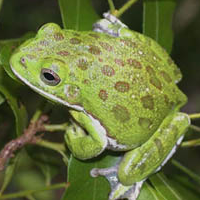
Photo: J.D. Willson
Description
Barking Treefrogs are the largest treefrogs in our region, averaging over 2 in (4.4 cm) in length. They are heavier-bodied and have more granular skin than green or squirrel Treefrogs, with which they can be confused. They are often bright green in coloration and usually have dark, round spots on their back and a white line on the lip that continues down each side.
Habitat
Barking Treefrogs spend much of the year high in trees and are most often seen during the breeding season when they congregate at wetlands. Breeding lasts from March to August, but calling is most intense in the early summer. Unlike most treefrogs in our region, males call from the water, often resembling tennis balls as the float, inflated, on the surface of wetlands.
For more information visit: https://srelherp.uga.edu/anurans/hylgra.htm
Bronze Frog
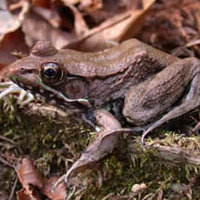
Photo: J.D. Willson
Description
A medium-sized frog: 7.5 to 12.5 cm (3 – 5 in), with dorso-lateral ridges that are well-defined, extending from the back of each eye down the back. The toes are extensively webbed and the second toe is longer than the first. Coloration is dark green but some individuals are more brown or yellow, and all have small irregular black spots and a white to yellow ventrum.
Habitat
Although found close to water, during heavy rains, juveniles may move into wooded areas or meadows. During the winter, Rana [L.] clamitans will bury themselves in the mud at the bottom of the pond or marsh to keep from freezing.
For more information visit: https://srelherp.uga.edu/anurans/rancla.htm
Bullfrog
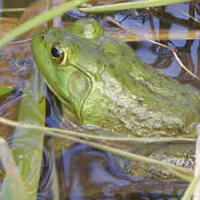
Photo: J.D. Willson
Description
The bullfrog is the largest frog in the U.S., ranging in length from 3.5 – 8 in (9 – 20 cm.). Coloration is normally plain green above, or a netlike pattern of gray or brown on a green background. The venter is whitish and often has grey mottling with a yellow wash, which is evident on the throats of adult males. In the southeastern part of the bullfrog’s range, coloration can be a heavy pattern of dark grey, brown, or black above, and thick mottling below.
Habitat
Although highly aquatic, Bullfrogs may be found moving about on land at night or in wet weather. They are often seen at the edge of ponds and lakes amidst emergent vegetation. Bullfrogs are voracious predators and will attach nearly anything that they can fit in their mouth including insects, other frogs, salamanders, small snakes and turtles, and even small birds. Breeding occurs in late spring and summer. Rather than forming large breeding choruses, male bullfrogs call sporadically throughout the breeding season. Each female lays 15,000 – 20,000 eggs each summer. Tadpoles attain very large sizes and take 1 – 3 years to metamorphose.
For more information visit: https://srelherp.uga.edu/anurans/rancat.htm
Cope’s Gray Treefrog
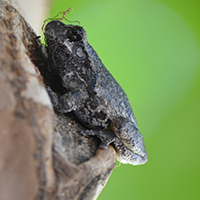
Photo: Zach Steinhauser
Description
Gray Treefrogs are the fairly large treefrogs (1.25 – 2 in; 3.2 – 5.1 cm) with large toe pads and granular skin. They are heavier-bodied than Pine Woods or Squirrel Treefrogs, with which they can be confused. They vary in color from mottled gray to light green but their color can change depending on environment and activity. There is usually a light spot beneath the eye, and the inner thigh is bright yellow or orange when exposed.
Habitat
Gray Treefrogs spend much of the year high in trees and are most often encountered during the breeding season when they call from vegetation surrounding wetlands. Breeding lasts from March to August, but calling is most intense in the early summer. Gray Treefrogs spend the day hiding in tree holes or other secluded areas and emerge at night to feed on insects and small invertebrates.
For more information visit: https://srelherp.uga.edu/anurans/hylchr.htm
Dusky Salamander
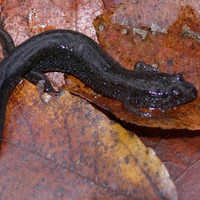
Photo: J.D. Willson
Description
Southern Dusky Salamanders are mid-sized — 3-5 in. (7.5-12.5 cm) – fairly stout salamander with back legs slightly larger than the front. A row of white spots, or “portholes,” runs along each side, posterior to front legs. The tail is slightly flattened. This species is variable in color but is dark brown to black, sometimes with a lighter patch running down the back. The underside is often flecked with white dots.
Habitat
Southern Dusky Salamanders seldom stray far from water and feed mostly on aquatic invertebrates. Breeding behavior occurs from September-October. Females lay 9-20 eggs under logs, rocks, or leaf litter and females sometimes protect the eggs. Eggs hatch in early fall and undergo metamorphosis the following spring.
For more information visit: https://srelherp.uga.edu/salamanders/desaur.htm
Dwarf Salamander
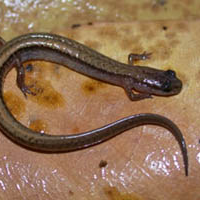
Photo: J.D. Willson
Description
The dwarf salamander is aptly named, as it is one of the smallest vertebrates in North America. Full-grown adults frequently weigh less than one gram and may be less than 2 inches long from snout to tail tip. Superficially, the dwarf salamander may look like a tiny southern two-lined salamander, but there is one sure character for diagnosis: The dwarf salamander has only four toes on each of its back feet, whereas all other Eurycea have five (as do most other salamanders).
For more information visit: https://srelherp.uga.edu/salamanders/eurqua.htm
Eastern Narrowmouth Toad

Photo: J.D. Willson
Description
Narrowmouth Toads are small, flattened frogs with pointed snouts and a fold of skin across the back of the head. They are typically around 1-1.5 in (2.5-4 cm). Overall color is generally gray to brown but can be extremely variable and can change from day to day or with the mood of an individual. The belly is usually heavily mottled.
Habitat
Narrowmouth Toads are secretive and are usually found by overturning boards or logs in woodland habitats. They feed on a variety of invertebrates but particularly ants. This species breeds in the summer and adults congregate at temporary water bodies, including large puddles and roadside ditches, to breed on rainy summer nights. Males call with only their snout protruding from the water and are often hard to locate. Eggs float on the surface of the water and tadpoles take 20-70 days to metamorphose.
For more information visit: https://srelherp.uga.edu/anurans/gascar.htm
Eastern Spadefoot Toad
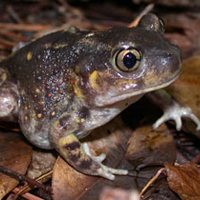
Photo: J.D. Willson
Description
The Eastern Spadefoot Toad is a large toad, ranging from 1.6 – 3.1 in (4 – 8 cm) long. Their skin is smoother and moister than other toads and is speckled with tiny warts. This species varies in coloration tan or yellowish to dark brown, without bold spots (as in other Southeastern Toads). They usually have two vertical light lines running from the back of their eyes down their dorsum, forming an hourglass shape. The lines are more brilliant yellow in males. The characteristics used to immediately distinguish this species from other species of toads are their bright yellow eyes with elliptical pupils (like cat eyes) and the dark spade, which is used for digging, on each hind foot.
Habitat
Spadefoot toads are extremely fossorial, spending most their life buried underground and are explosive breeders. Heavy rains, occurring at nearly any time of year, cause them to emerge in large numbers and congregate at breeding in wetlands or ephemeral pools created by the rain. Males call while floating on the surface of the water. Females can lay up to 2,500 eggs at once. Tadpoles grow very quickly and can undergo metamorphosis in as few as 28 days. Data from the Savannah River Ecology Lab have shown that this species is very long lived and populations often go for many years without successful reproductive events.
For more information visit: https://srelherp.uga.edu/anurans/scahol.htm
Green Treefrog
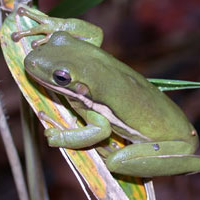
Photo: J.D. Willson
Description
The green treefrog is a medium-sized – 1.25 – 2.25 in (3.2-5.7 cm) frog that, like other treefrogs, has long limbs, long digits, and sticky toe pads. This frog is green with a white, yellow or sometimes iridescent stripe along each side of the body. The length of these stripes varies among some populations and, indeed, may not be present at all. Additionally, yellow flecks are often found on the dorsum of some individuals. Males are smaller than females.
Habitat
Green Treefrogs are arboreal and spend much of their lives in trees. They are also frequently encountered near porch and patio lights throughout the south during warm, wet weather; they enjoy the abundant supply of insects attracted to the light. They are nocturnal animals and males call while perched on plants adjacent to water (up to 5m high) or from floating vegetation. The calling season extends from March to October. This species is more resistant to fish than many amphibian species in our region.
For more information visit: https://srelherp.uga.edu/anurans/hylcin.htm
Leopard Frog
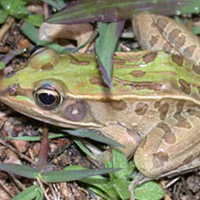
Photo: J.D. Willson
Description
Southern Leopard Frogs (Rana [Lithobates] spenocephala) are mid-sized frogs — 2 – 3.5 in (5.1 – 8.9 cm), that are brownish to green in ground color with large dark green to brown spots on its back, sides, and legs (spots on the sides and legs may be smaller than those on the back). The upper jaw has a light, sometimes yellow stripe.
Habitat
Although Leopard Frogs are often found close to water, they are more terrestrial than other ranid frogs and can often be found far from water. They are active both by day and night and can be seen in large numbers on rainy nights. Leopard frogs breed primarily in the winter and spring but sometimes breed again in the fall. Often a heavy winter rain will prompt explosive breeding in this species.
For more information visit: https://srelherp.uga.edu/anurans/ransph.htm
Marbled Salamander

Photo: J.D. Willson
Description
Marbled Salamanders grow to about 3.5-4.25 in (9 – 10.7 cm) in size and are stout-bodied and chubby in appearance. They can be identified by their black/dark brown body (including its venter) with light white/silvery crossbands on the dorsum. This species is sexually dimorphic, males tend to have white crossbands and females tend to have gray/silvery crossbands. These crossbands, though, are not present in newly transformed juveniles, which have flecks instead.
Habitat
Adult Marbled Salamanders are nocturnal and burrow or take refuge under logs or other cover during the day. They are perhaps most often encountered when they migrate to wetlands to breed on rainy nights in September and October. Marbled salamanders breed in autumn (unlike most other mole salamanders which breed in winter) and migrate to wetlands during/before a good rain to court and mate. Females will lay about 30-100 eggs in a depression on land (usually beneath a log or leaf litter). The female stays with her developing eggs until rain fills the wetland and triggers the eggs to hatch. If the rain never comes, then the eggs have the ability to over winter until spring to hatch.
For more information visit: https://srelherp.uga.edu/salamanders/ambopa.htm
Red Salamander
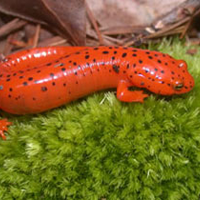
Photo: J.D. Willson
Description
Red salamanders are one of the largest stream salamanders in our region (4 – 6 in; 10 -15 cm). They are stout-bodied and short-tailed (tail length about 80% of snout-vent length). Coloration is bright red to reddish orange with many irregularly rounded, black spots with a somewhat lighter belly.
Habitat
Red Salamanders are most frequently encountered under rocks, logs, and other cover objects near streams or seeps. Although they take cover under such objects by day, they are active at night when they search for invertebrate and small vertebrate prey. In some regions, the bulk of Red Salamander diets consists of other salamanders. Adults are frequently found crossing roads on rainy nights. Breeding occurs between June and September with spawning in October (averaging around 70 eggs/clutch).
For more information visit: https://srelherp.uga.edu/salamanders/pserub.htm
Red-spotted Newt
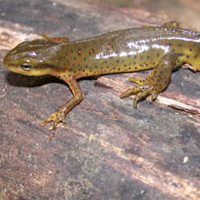
Photo: J.D. Willson
Description
Salamandrids are collectively known as the “newts,” a term which often breeds some confusion — as in “What is the difference between a salamander and a newt?” The simple answer is nothing: a newt is simply a specific type of salamander, namely members of the family Salamandridae. In other words, all newts are salamanders, but not all salamanders are newts.
For more information visit: https://srelherp.uga.edu/salamanders/notvir.htm
River Frog
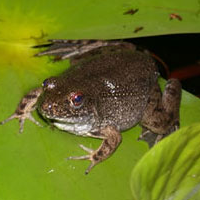
Photo: J.D. Willson
Description
Adult river frogs (Rana [Lithobates] heckscheri) are large frogs, ranging from 3 to 5 inches (7-13 cm) long. The record length is over 6 inches (15.5 cm). The dorsal surface can vary from green, dark green, to greenish black. The venter can be almost completely black, but is usually medium to dark gray. The belly also has short wavy lines or light spots.
Habitat
These frogs are nocturnal and are more easily approached than other frogs. Instead of fleeing, river frogs will often play dead and go limp or secrete an unpleasant odor. They breed from April to early August. The large tadpoles of river frogs can reach a size of up to 5 inches. The tadpoles also demonstrate schooling behavior, which is uncommon among frogs with large tadpoles.
For more information visit: https://srelherp.uga.edu/anurans/ranhec.htm
Slimy Salamander
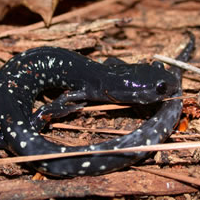
Photo: J.D. Willson
Description
Slimy Salamanders were once considered one species (P. glutinosus) but have recently been split into 13 separate species. They all look similar and are best differentiated by range. Slimy salamanders are large salamanders, reaching 6.75 in (17 cm), with blackish-blue color and scattered silvery-white or gold spots all over their body. Its tail is round, and its venter is grayish black or slightly lighter than the dorsum. The Slimy salamander gets its name from the slimy secretions it produces when threatened, which stick like glue and are hard to get off. They have approximately 16 costal grooves.
Habitat
Slimy Salamanders prefer to stay under logs, stones, debris, or in burrows during the day and come out on moist nights forage for invertebrate prey. During the breeding season male adult Slimy Salamanders, unlike females, have a large mental gland on the chin, which they use to stimulate the female. They breed annually, depositing about 6-36 eggs under logs or dirt in the summer or early fall. These eggs will usually hatch around October, and young do not have an aquatic larval stage. They mature in about 3 years.
For more information visit: https://srelherp.uga.edu/salamanders/pleglu.htm
Spotted Salamander
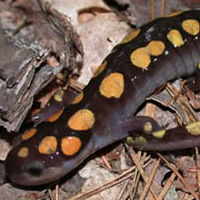
Photo: JD Willson
Description
Spotted Salamanders are a large salamander, ranging from 6-9.5 inches (15-24 cm) in length. Ground color can be shades of black, gray or brown on its back, gray on its belly. Down each side of the back, there are two rows of orange and yellow spots; sometimes as many as 50. Ambystoma maculatum is considered monotypic (no recognized subspecies) and has 12 costal grooves.
Habitat
The Spotted Salamander is fossorial, active at night, and is rarely seen except during breeding seasons. They breed during the winter and early spring when adults migrate from their burrows to pools during winter rains. They exhibit courtship breeding patterns and internal fertilization. Females lay large clumps of up to 200 eggs in shallow pools, often associated with algae. There is believed to be a symbiotic relationship between the algae and the salamander, where the algae are provided with a safe place to live and grow and in turn, algae produce oxygen, which is needed for embryonic development of the larvae. Eggs hatch in four to eight weeks, and larvae metamorphose in two to four months. Adults can live for two decades.
For more information visit: https://srelherp.uga.edu/salamanders/ambmac.htm
Tiger Salamander
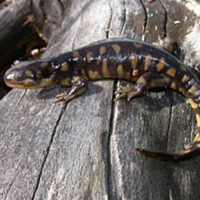
Photo: J.D. Willson
Description
In other parts of its extensive range, the tiger salamander may be the most frequently encountered salamander. In the Southeast, however, it is less common. Tiger salamanders are usually found as eggs or larvae instead of adults, in temporary and permanent ponds that are open and grassy. Unlike in other parts of its range, tiger salamanders in the Southeast appear to be incapable of paedomorphosis, and the famous “cannibal morph” has not been collected in the eastern United States. The larvae have astounding growth rates and can achieve metamorphic size (up to 5 or 6 inches) in just a couple of months. These are the largest terrestrial salamanders on in the southeast and may approach 8 inches in total length. Adults are usually black with yellow markings that may come in the form of spots, blotches, bands or even short stripes.
For more information visit: https://srelherp.uga.edu/salamanders/ambtig.htm
Two-lined Salamander
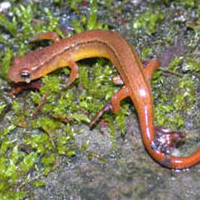
Photo: JD Willson
Description
Most members of Genus Eurycea are yellowish, at least ventrally. Eurycea wilderae is no exception. A fairly small salamander – Snout-vent length 2.75 – 3 in (7-10.7 cm) — that is distinguished from other salamanders within its range by its striking yellow or orange body and broad dark stripes. It closely resembles the southern two-lined salamander (Eurycea cirrigera) and is best distinguished by range and greater saturation of yellow or orange color and pattern. Males have longer legs than females, a mental gland, and nostril projections (cirri) during the mating season.
Habitat
Two-Lined Salamanders are often found hiding under rocks, leaf packs and other organic debris along streams, above and below water. These salamanders also frequently venture into warm, wet forests. Their larvae are aquatic.
For more information visit: https://srelherp.uga.edu/salamanders/eurwil.htm
Bumble Bee
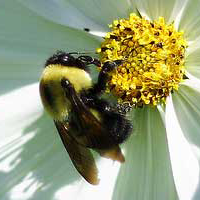
Photo: Rosana Prada
Habitat
The common eastern bumble bee can be found throughout the east coast from Maine to Florida and west through Ohio. Look for the common eastern bumble bee flying through the air in spring and summer near gardens, farms, and backyards. Their nests are located in woodlands and fields.
Feeding Behavior
The common eastern bumble bee is a pollinator of flowers and numerous fruit and vegetable crops, including tomatoes, blueberries, and cucumbers. Bumble bees have fur all over their bodies; these hairs collect and trap pollen which the bees carry from one bloom to another.
For more information visit: https://www.nwf.org/Wildlife/Wildlife-Library/Invertebrates/Common-Eastern-Bumble-Bee.aspx
Daddy Long Leg
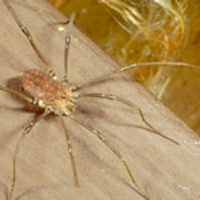
PHOTO: Univ. Kentucky – R. Bessin 2002
Habitat
Daddy-longlegs are generally beneficial. In the fall, they can become a nuisance when they congregate in large clusters on trees and homes, usually around eves and windows. Additionally they can be found in damp crawl spaces, unfinished basements, and garages. Rarely are daddy-longlegs encountered inside finished, living spaces of homes.
Feeding Behavior
They have a very broad diet that includes spiders and insects, including plant pests such as aphids. Daddy-longlegs also scavenge for dead insects and will eat bird droppings.
For more information visit: https://www.clemson.edu/cafls/departments/esps/factsheets/household_structural/daddy_longlegs_hs47.html
Honey Bee
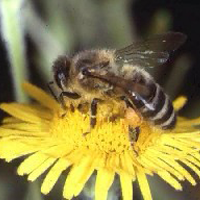
Photo: Everything About Honey Bee
Habitat
The honey bee is a social insect that can survive only as a member of a community, or colony. The colony inhabits an enclosed cavity, its nest. Domesticated colonies are kept in artificial containers, usually wooden boxes, known as hives.
Feeding Behavior
As with all bees, pollen is the principal source of protein, fat, minerals, and vitamins, the food elements essential for the growth and development of larvae of all three castes. Adult bees can subsist on honey or sugar, a pure carbohydrate diet.
For more information visit: https://www.everythingabout.net/articles/biology/animals/arthropods/insects/bees/honey_bee/
Lady Bug
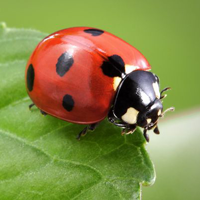
Photo:
Habitat
Most lady beetles found on crops and in gardens are aphid predators. Some species prefer only certain aphid species while others will attack many aphid species on a variety of crops. Some prefer mite or scale species. If aphids are scarce, lady beetle adults and larvae may feed on the eggs of moths and beetles, and mites, thrips, and other small insects, as well as pollen and nectar. They may also be cannibalistic. Because of their ability to survive on other prey when aphids are in short supply, lady beetles are particularly valuable natural enemies.
Feeding Behavior
Lady beetles, both adults and larvae, are known primarily as predators of aphids (plant lice), but they prey also on many other pests such as soft-scale insects, mealybugs, spider mites and eggs of the Colorado Potato Beetle and European Corn Borer. A few feed on plant and pollen mildews. One larva will eat about 400 medium-size aphids during its development to the pupal stage. An adult will eat about 300 medium-size aphids before it lays eggs. About three to ten aphids are eaten for each egg the beetle lays. More than 5,000 aphids may be eaten by a single adult in its lifetime. The lady beetle’s huge appetite and reproductive capacity often allow it to rapidly clean out its prey.
Apart from aphids, ladybugs also require a source of pollen for food and are attracted to specific types of plants. The most popular ones have umbrella shaped flowers such as fennel, dill, cilantro, caraway, angelica, tansy, wild carrot & yarrow. Other plants that also attract ladybugs include cosmos (especially the white ones), coreopsis, and scented geraniums, dandelions.
For more information visit: https://www.gardeninsects.com/ladybugs.asp
Monarch Butterfly
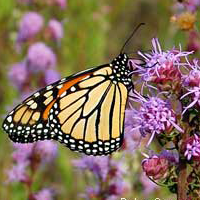
Photo: Peter Gorman
Habitat
Monarch butterflies utilize different habitat in the warm months versus the cold months. In the spring, summer and early fall, they can be found wherever there are milkweeds. Monarchs lay their eggs on milkweeds, and they’re always searching for them in fields, meadows, and parks. Many people plant milkweeds in their gardens.
Feeding Behavior
Monarchs, like all butterflies, change their diet as they develop. During the caterpillar stage, they live exclusively on milkweed plants. Milkweeds are wildflowers in the genus Asclepias. Milkweeds contain glycoside toxins that are harmless to the monarch but poisonous to its predators. Monarch caterpillars feed on all the different parts of milkweed plants and store up the toxins in their body. The toxins remain in their system even after metamorphosis, thereby making adult monarchs poisonous as well.
For more information visit: https://www.nwf.org/Wildlife/Wildlife-Library/Invertebrates/Monarch-Butterfly.aspx
Praying Mantis
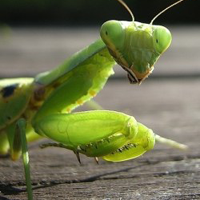
Photo: OpenCage licensed under Creative Commons.
Habitat
Typically green or brown and well camouflaged on the plants among which they live, mantis lie in ambush or patiently stalk their quarry. They use their front legs to snare their prey with reflexes so quick that they are difficult to see with the naked eye. Their legs are further equipped with spikes for snaring prey and pinning it in place.
Feeding Behavior
The praying mantis, a master at camouflage, hunts throughout the day. Driven by hunger from the time of its hatching, it may eat its brothers and sisters if it can find no other food. Even more ravenous by the time it reaches adulthood, it may either ambush or stalk its prey. It strikes so swiftly that you can scarcely see the movement. It uses the spines on its front legs to impale and clutch its prey, immediately beginning to chew into the throat. Given the opportunity, it may hold one victim with one front leg and snatch another with the other front leg, feeding gluttonously on them both. While the praying mantis prefers cockroaches and flies, it may attack any number of other insects as well as spiders, salamanders, frogs, mice and hummingbirds.
Swallowtail Butterfly
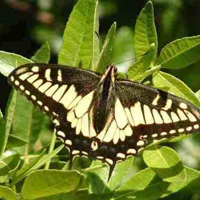
Photo:
Habitat
The black swallowtail is found in open areas including fields, parks, and meadows.
Feeding Behavior
The black swallowtail caterpillar feeds on many different plants in the Apiaceae, or carrot family, including Queen Anne’s lace, celery, parsley, carrots, dill, and parsnip. The butterfly eats nectar from a variety of plants including clover, milkweed, thistles, and phlox.
For more information visit: https://www.nhptv.org/wild/karnerblackswallowtail.asp

